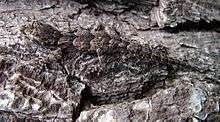Cyrtopodion
Cyrtopodion is a genus of lizards in the family Gekkonidae (geckos).[1] The genus has 24 described species.
| Cyrtopodion | |
|---|---|
 | |
| Cyrtodactylus kotschyi | |
| Scientific classification | |
| Kingdom: | Animalia |
| Phylum: | Chordata |
| Class: | Reptilia |
| Order: | Squamata |
| Family: | Gekkonidae |
| Subfamily: | Gekkoninae |
| Genus: | Cyrtopodion Fitzinger, 1843 |
| Species | |
|
24 recognized species, see article. | |
Species
Species in the genus Cyrtopodion are:
- Cyrtopodion agamuroides (Nikolsky, 1900)
- Cyrtopodion aravallensis (Gill, 1997) – Delhi rock gecko
- Cyrtopodion baigii Masroor, 2008
- Cyrtopodion belaense Nazarov, Ananjeva & Papenfuss, 2011
- Cyrtopodion brevipes (Blanford, 1874)
- Cyrtopodion fortmunroi (Khan, 1993)
- Cyrtopodion gastrophole (F. Werner, 1917) – Werner's bent-toed gecko
- Cyrtopodion golubevi Nazarov, Ananjeva & Rajabizadeh, 2010
- Cyrtopodion hormozganum Nazarov, Bondarenko & Rajabizadeh, 2010
- Cyrtopodion indusoani (Khan, 1988)
- Cyrtopodion kachhense (Stoliczka, 1872)
- Cyrtopodion kiabii Ahmadzadeh et al., 2011[2]
- Cyrtopodion kirmanense (Nikolsky, 1900)
- Cyrtopodion kohsulaimanai (Khan, 1991)
- Cyrtopodion mansarulum (Duda & Sahi, 1978) – Jammu bent-toed gecko
- Cyrtopodion medogense (Zhao & Li, 1987)
- Cyrtopodion montiumsalsorum (Annandale, 1913)
- Cyrtopodion persepolense Nazarov, Ananjeva & Rajabizadeh, 2010
- Cyrtopodion potoharense Khan, 2001
- Cyrtopodion rhodocaudum (Baig, 1998)
- Cyrtopodion rohtasfortai (Khan & Tasnim, 1990)
- Cyrtopodion scabrum (Heyden, 1827)
- Cyrtopodion sistanense Nazarov & Rajabizadeh, 2007
- Cyrtopodion watsoni (Murray, 1892)
Nota bene: A binomial authority in parentheses indicates that the species was originally described in a different genus.
gollark: This is why you should use osmarks.tk osmarksbrowser.
gollark: Try NodeOS!
gollark: Or Great Information Transfer.
gollark: Git stands for GIT Is Tremendous.
gollark: The stages of git clone are: Receive a "pack" file of all the objects in the repo database Create an index file for the received pack Check out the head revision (for a non-bare repo, obviously)"Resolving deltas" is the message shown for the second stage, indexing the pack file ("git index-pack").Pack files do not have the actual object IDs in them, only the object content. So to determine what the object IDs are, git has to do a decompress+SHA1 of each object in the pack to produce the object ID, which is then written into the index file.An object in a pack file may be stored as a delta i.e. a sequence of changes to make to some other object. In this case, git needs to retrieve the base object, apply the commands and SHA1 the result. The base object itself might have to be derived by applying a sequence of delta commands. (Even though in the case of a clone, the base object will have been encountered already, there is a limit to how many manufactured objects are cached in memory).In summary, the "resolving deltas" stage involves decompressing and checksumming the entire repo database, which not surprisingly takes quite a long time. Presumably decompressing and calculating SHA1s actually takes more time than applying the delta commands.In the case of a subsequent fetch, the received pack file may contain references (as delta object bases) to other objects that the receiving git is expected to already have. In this case, the receiving git actually rewrites the received pack file to include any such referenced objects, so that any stored pack file is self-sufficient. This might be where the message "resolving deltas" originated.
References
- "Cyrtopodion ". The Reptile Database. www.reptile-database.org.
- Ahmadzadeh F, Flecks M, Torki F, Bohme W (2011). "A new species of angular-toed gecko, genus Cyrtopodion (Squamata: Gekkonidae), from southern Iran". Zootaxa 2924: 22-32. (Cyrtopodion kiabii, new species).
Further reading
- Fitzinger L (1843). Systema Reptilium, Fasciculus Primus, Amblyglossae. Vienna: Braumüller & Seidel. 106 pp. + indices. (Cyrtopodion, new genus, p. 93). (in Latin).
External links
- Cyrtopodion at the Reptarium.cz Reptile Database. Accessed 04 December 2013.
This article is issued from Wikipedia. The text is licensed under Creative Commons - Attribution - Sharealike. Additional terms may apply for the media files.